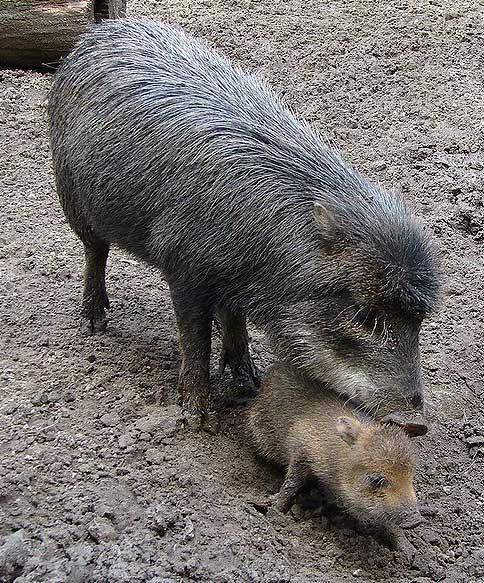
Tayassu pecari (*)
Cladus: Eukaryota
Supergroup: Opisthokonta
Regnum: Animalia
Subregnum: Eumetazoa
Cladus: Bilateria
Cladus: Nephrozoa
Cladus: Deuterostomia
Phylum: Chordata
Subphylum: Vertebrata
Infraphylum: Gnathostomata
Superclassis: Tetrapoda
Classis: Mammalia
Subclassis: Theria
Infraclassis: Placentalia
Superordo: Cetartiodactyla
Ordo: Artiodactyla
Subordo: Suina
Familia: Tayassuidae
Genus: Tayassu
Species: Tayassu pecari
Subspecies: T. p. aequatoris - T. p. albirostris - T. p. pecari - T. p. ringens - T. p. spiradens
Name
Tayassu pecari
Vernacular names
English: White-lipped Peccary
日本語: クチジロペッカリー
Português: Queixada
Русский: Белогубые пекари
The White-lipped Peccary, Tayassu pecari, is a peccary species found in Central and South America, living in rainforest, dry forest and chaco scrub. It is monotypic within the genus Tayassu.
The white-lipped peccary is diurnal and lives in large herds of 50 to 300+ individuals, though there have been reported sightings of up to 2,000 individuals. It is an omnivorous animal, feeding on fruits, roots, tubers, palm nuts, grasses and invertebrates.
Like the collared peccary, it is a main prey species of the jaguar and, less frequently, of the cougar.
The white-lipped peccary is widely considered the most dangerous peccary; unlike the rather shy collared peccary, the white-lipped species will charge at any enemy if cornered, and when one of them is injured, the entire herd returns to defend it. There are reports of jaguars being killed by angered peccary herds and even some humans have been killed.
Distribution
The white-lipped peccary is found in Central America and South America. It ranges from southeast Mexico, throughout eastern Central America, to northern Argentina. The white-lipped peccary was introduced to Cuba in 1930, but possibly is no longer found there. According to the IUCN it's already extirpated in El Salvador and its range has been reduced in Mexico and Central America during the last 20 years.[2]
References
^ Reyna-Hurtado, R., Taber, A., Altrichter, M., Fragoso, J., Keuroghlian, A. & Beck, H. (2008). Tayassu pecari. In: IUCN 2008. IUCN Red List of Threatened Species. Downloaded on 6 November 2009. Database entry includes a brief justification of why this species is of near threatened.
^ http://www.iucnredlist.org/apps/redlist/details/41778/0/full Retrieved on August 5
Louise H. Emmons and Francois Feer, 1997 - Neotropical Rainforest Mammals, A Field Guide.
Reyna-Hurtado, R., Taber, A., Altrichter, M., Fragoso, J., Keuroghlian, A. & Beck, H. (2008). Tayassu pecari. In: IUCN 2008. IUCN Red List of Threatened Species. Downloaded on 23 February 2009.
Retrieved from "http://en.wikipedia.org/"
All text is available under the terms of the GNU Free Documentation License

